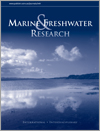Marine and Freshwater Research
Volume 75
Number 9 2024
With its high value timber, Xylocarpus granatum could make an excellent addition to mangrove restoration programs. Using field data from sites in estuaries in northern Australia and Papua New Guinea, we showed that X. granatum can grow as fast as most mangrove species when annual rainfall is high and sediments are well aerated and have high silt and phosphorus contents.
Many inland waters act as a source of carbon dioxide (CO2) to the atmosphere. The ecosystem metabolic balance determines this response, making it a key topic of study, including its interactions with drivers of global change to acknowledge future responses. In this study, new experimental units and novel collapsed factorial designs are employed to address the potential shift from source to sink of CO2 from inland freshwaters.
Predicting how species arrange themselves in the environment is vital for managing fish populations and understanding ecological processes. This study finds that two species of closely related fish that live in the same environment evolved to respond differently to environmental conditions, and therefore exhibit fine-scale differences in habitat use to allow their coexistence.
We examined seasonal patterns in body condition of Rio Grande silvery minnow over 3 years. Body condition may help predict spawning success or highlight human impacts to fish populations. Contrary to our expectations, fish body condition did not seem to be related to drought conditions, possibly because these small fish do not build an energy reserve before spawning.
We identified global hotspots of aquatic macrophyte endemism and rarity, and identified factors associated with speciation hotspots of macrophytes in some areas of the planet. We found a total global pool of world-rare macrophytes of 2296 species, each present in <5% of the total world area of inland aquatic habitats. Our findings help identify the locations of potential cradle and museum speciation areas for these plants, that could usefully inform global actions to conserve freshwater macrophyte diversity across the world.
This article belongs to the collection Ecology and Management of Aquatic Macrophytes.
Diadromous fishes, which migrate between freshwater and marine habitats during their life cycle, are crucial components of riverine biodiversity. However, the factors that influence their composition within rivers remain unknown. Using environmental DNA metabarcoding, we showed that river slopes play a crucial role in shaping their composition within rivers by affecting their upstream migration and estuarine habitat availability.
This study aimed to assess the genetic diversity, population structure and demographic history of Striostrea prismatica, an ecologically and commercially important native oyster in Mexico, Ecuador and Peru, using nuclear and mitochondrial DNA markers. Nuclear data revealed high intraspecific genetic diversity and strong genetic differentiation. Mitochondrial data showed high haplotypic diversity, no genetic structure and a population expansion c. 25,000 years ago.
Freshwater-quality prediction is crucial for monitoring pollution risks and assessing changes in freshwater ecosystems. Whereas Kriging is a precise interpolation method for predicting freshwater quality, selecting key parameters, regression functions and correlation functions remains challenging. Therefore, this study proposed an adaptive weighted-average Kriging (AWAK) method that outperforms traditional Kriging in predicting pH and dissolved oxygen, reducing prediction errors significantly. Overall, AWAK improved freshwater-quality prediction and provided an effective approach in freshwater-ecology research.
This article belongs to the collection Ecological Monitoring and Assessment of Freshwater Ecosystems.





